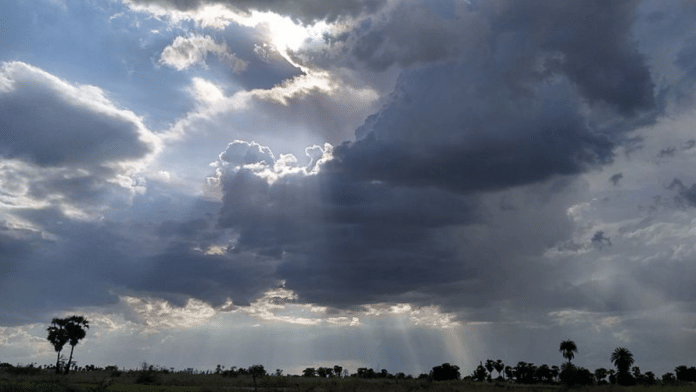New Delhi: The concentration of toxic gas, SO2, in India’s atmosphere has steadily declined in the past decade due to environmental regulation and control technologies, a study has found.
A team of researchers from the Indian Institute of Technology (IIT), Kharagpur, found that SO2 was mainly emitted by coal-fuelled power plants, and other manufacturing and concentration industries.
The scientists, led by Jayanarayanan Kuttippurath, monitored the sulphur dioxide concentration for over four decades. Their findings were published in June 2022, in a study titled, ‘Improvements in SO2 pollution in India: role of technology and environmental regulations.’
The study highlighted that a majority of coal-based power plants in India use bituminous coal, sub-bituminous coal, or lignite, which contain 0.7% sulphur by weight.
Climate scientist and lead author Jayanarayanan Kuttippurath told ThePrint: “Coal-based thermal power plants and manufacturing and construction industries are the major sources of atmospheric SO2 in India. However, biomass burning, chemical and fertilizer industries, and petroleum industry also contribute to the SO2 pollution.”
The study said that thermal power plants contributed 51 per cent to SO2 concentration and the construction sectors contributed 29 per cent for the last 40 years.
Sulphur dioxide was described as a “criteria pollutant” by the European Commission in 2015, and by the US Environmental Protection Agency in 2016. SO2 severely degrades air quality and has an adverse impact on the human respiratory system, the scientists said. They added that even short-term exposure to high levels of it could cause death. Even the discolouration seen on the Taj Mahal is due to the marble reacting with SO2.
Kuttippurath said SO2 also causes “acid rain”. “This acid rain can seep into the soil and degrade the quality and quantity of plant yield as well. Acid rain in the soils can change its pH and alter their fertility. This is another pathway of ecosystem damage.”
Acid rain is a menacing reality today. A pH range of 4.77 to 5.32 was found in rainwater samples from Nagpur, Mohanbari (in Assam), Allahabad, Visakhapatnam, and Kodaikanal between 2001 and 2012, in a previous study conducted by the Indian Meteorological Department and the Indian Institute of Tropical Meteorology.
The IIT study also found that SO2 concentration was lowest in the monsoon, but reached its peak in winter. During monsoon, the sulfate particles are scavenged by clouds and raindrops and by oxidation of the SO2 dissolved in the drops. Winter sees a greater dispersion of SO2 in the atmosphere due to lower temperatures and reduced wind speed, which allows for greater spread of pollutants.
Over the four decades of the study, an increase in SO2 is noted from 1980 to 2010. This could be attributed to rapid economic development. But, a sudden reduction is seen after that, all the way to 2022.
The researchers said that flue gas desulphurisation at industrial plants may have contributed to the shift. This control technology is a process of eliminating sulphur compounds from emissions, and is done by adding absorbents.
The researchers added that the increase in renewable energy production in India has also increased since 2015, which has reduced SO2 emissions.
In fact, India recorded an encouraging result just recently, in 2019. The country saw a major drop of 6% in SO2 emissions in India, as the country consumed less coal.
“Renewable energy production in India has been increasing for the past few years. Moreover, India’s nationally determined contributions under the Paris Agreement for the period 2021–2030 include achieving about 40% cumulative electric power installed capacity from non-fossil fuel based energy resources by 2030. This could help to reduce the dependency on coal for energy, and also help to curb the SO2 emissions,” Jayanarayanan said.
However, in spite of the 10-year decrease, the concentration of the gas is still very high across the Indo-Gangetic Plain and in central and eastern India.
Jayanarayanan told ThePrint, “These regions have loads of industries and mining activities going on.” In fact, in these regions, the concentration of SO2 is almost twice that of northwest India and northeast India.
In India, power plants with a capacity of more than 300 MW contribute to most SO2 emissions, with 63% coal consumption growth. The largest thermal power plant is in Singrauli, Madhya Pradesh which has a capacity of more than 300 MW.
“A shift towards renewable energy is one of the best ways to tackle this crisis. Additionally, the strong environmental regulation for the installation of scrubber and FGD technology to remove SO2 from emissions at each power plant can reduce the SO2 pollution significantly. In the last decade, China reduced its SO2 emissions significantly, where the implementation of these environmental technologies played a key role. With this approach, we can meet our energy demand and control the air pollution simultaneously,” Jayanarayanan added.
Other than that, government regulation on vehicle emission has also contributed to SO2 decrease over the years. The Bharat Stage emission standards (BS) III in 2010, BSIV in 2017, and BSVI in 2020 imposed strict limits on all major on-road vehicle categories in India. These limits ensured that a vehicle can only pollute this much and no more.
Also read: Climate change deadlier than cancer, widening gap between haves, have-nots, says new UN study






